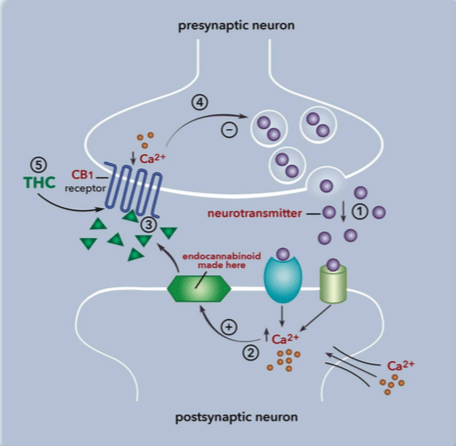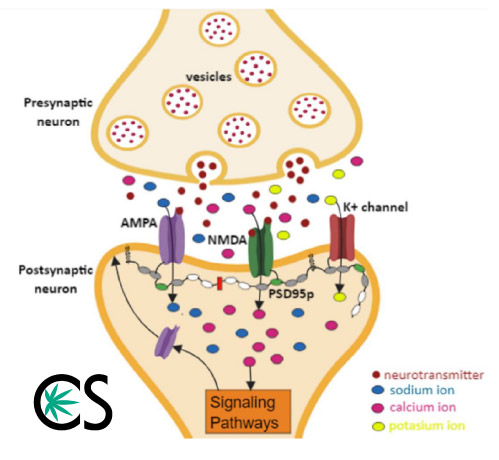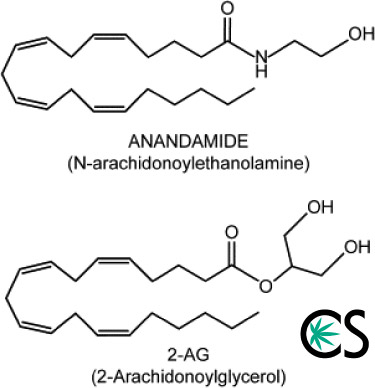The endocannabinoid system is a complex bodily system that is actually responsible for a number of different things.
It wasn’t discovered until the mid-1990s, either.
A lot of the reasons that people report so much success with CBD products, including CBD gummies, CBD topicals, CBD flower, and CBD cigarettes can be attributed to the endocannabinoid system.
What is the Endocannabinoid System?
Each cell has many receptors, all of which are activated by special compounds specific to them – glutamate bind to glutamate receptors; serotonin to serotonin receptors; dopamine to dopamine receptors, endocannabinoids to cannabinoid receptors, and a whole lot more!
The endocannabinoid system is made up of the CB1 and CB2 receptors, which are activated by the two main endocannabinoids, anandamide and 2-AG.
Anandamide binds to the CB1 receptors, while 2-AG bind to both the CB1 and CB2 receptors.

The endocannabinoid system is our body’s system of endocannabinoid receptors and the endocannabinoids that interact with them.
An easy way to understand how the endocannabinoid system works is to think of it as a lock and key mechanism.
The cannabinoid receptors are the locks, and the endocannabinoids are the keys.
When the endocannabinoids bind to the cannabinoid receptors, they are able to produce physiological responses necessary for keeping cells alive and healthy.
In fact, you can say that the endocannabinoid system is one of the most important systems in the body because its main function is to maintain balance and homeostasis.
Why is This System Important?
As mentioned, the endocannabinoid system is a very integral system that modulates almost everything within the body.
The endocannabinoid system regulates:
- Gastrointestinal activity
- Cardiovascular activity
- Pain Perception
- Modulation of neurotransmitter release
- Maintenance of bone mass
- Protection of neurons
- Hormonal regulation
- Metabolism control
- Immune function
- Inflammatory reactions
- Inhibition of tumor cells

As you can see, your endocannabinoid system is responsible for a lot of important functions going on in your body! The endocannabinoid system is the gatekeeper of homeostasis. So how does the endocannabinoid system modulate almost everything?
How does it work?
Before I tell you how the endocannabinoid system works, I’ll briefly explain to you how signals are normally transmitted by the cells. This is important because this is one of the factors that make the endocannabinoid system unique.
Our cells communicate through chemical signals.
When a stimulus stimulates a cell, it will trigger the presynaptic portion of the cell to release chemicals, be it hormones, neurotransmitters, special proteins, signaling molecules, etc.

Now, the chemical signal will travel in a forward direction.
It will go from the presynaptic cell, cross the synapse, and bind to its specific receptor on the postsynaptic cell. And on and on the signal will go until it reaches the brain. The brain will then release chemicals that carry the command for how the body will react to the stimulus.
Now this is where the endocannabinoid system really gets interesting. A stressor like a noxious stimulus will also trigger the endocannabinoid system to release endocannabinoids.
But instead of the presynaptic cell releasing the endocannabinoids, it is the postsynaptic cell that releases the chemical.
Endocannabinoids, unlike most neurotransmitters, travel in a backward direction called retrograde signaling[vi].
The postsynaptic neuron will release endocannabinoids, and the endocannabinoids will cross the synapse to attach to the presynaptic neuron’s cannabinoid receptors. What happens next is beautiful.
Endocannabinoids, when they bind to their receptors, have the ability to modulate the neuron’s activity.
This is how the endocannabinoid system maintains balance in the body. Take for example a neurological disease. The result of too many excitatory neurotransmitters in the brain will cause the receptors to become overexcited and overactive.

Because there is an imbalance, there will be a worsening of the disease. Case in point: stress and anxiety disorders.
Attaching to Receptors
Now the endocannabinoids, when they’re released and attach to their receptors, can tell the neuron to stop producing or stop absorbing the excitatory neurotransmitters.
The neuron will listen and “calm down,” so homeostasis and balance are once more achieved in the body.
What this means is that even when a signal has already been fired by a neuron, endocannabinoids can still influence the neuron and change its response to the stimulus because of retrograde signaling.

The endocannabinoid system is a like a guard always watching over your body, ready to take action anytime there is a disturbance.
Here’s another very interesting thing about our endocannabinoid system:
Upon injury, immune cells will flock to the site of the injury and release a protein called cytokine. The cytokine will then send the signal that it needs more immune cells in the area. On and on the cytokines will recruit more immune cells.
They only stop recruiting when anti-inflammatory proteins tell the immune cells to stop their cytokine production. Now, inflammation is a good thing since it’s our natural and first-line-of-defense against irritants and pathogens.
But sometimes, the inflammatory process can become overactive and worsen the medical condition, which effectively delays the healing process.
In fact, there are numerous medical conditions worsened by inflammation – rheumatoid arthritis, multiple sclerosis, cancer, neuropathic pain, among others.
Endocannabinoids have the ability to inhibit inflammation by binding to the CB2 receptors of the cytokine-producing immune cells. When these receptors are stimulated, they produce widespread anti-inflammatory effects by causing the apoptosis (cell death) of the immune cells.
With the immune cells inactivated, there will be no more production of cytokines. Inflammation is controlled and proper healing can start
Location of Cannabinoid Receptors
The cannabinoid receptors we currently know the most about are the CB1 and CB2 receptors.
In the future, researchers will likely find more cannabinoid receptors in the body.
Cannabinoid receptors are found all over the body. They are literally everywhere – the brain, the spinal cord, the immune system, the internal organs, the peripheral nervous system, and even on the skin!
In fact, the endocannabinoid system is the most widespread receptor system in the human body.
However, the CB1 receptors are predominantly found in the central nervous system – your brain and spinal cord; the CB2 receptors are predominantly found in the immune system, specifically the white blood cells.

Stimulating the CB1 receptors produces a myriad of effects.
It regulates so many physiological processes – sleep, memory, emotional responses, mood, appetite, and temperature, among others.
It can even regulate the sensation of pain.
Stimulating the CB2 receptors, on the other hand, produces widespread anti-inflammatory effects since they are mostly located in the immune cells.
There is the possibility that there is a third cannabinoid receptor, but its location and how it functions haven’t been clearly defined yet.
What are Endocannabinoids?
There are two main types of endocannabinoids. They are anandamide and 2-AG.
Anandamide is the most studied and activates the CB1 receptors to produce their beneficial effects.

Unfortunately, anandamide is a short-order neurotransmitter.
The body only produces this endocannabinoid when it needs it.
Also, anandamide doesn’t stay long in the body because it’s easily degraded by an enzyme called fatty acid amide hydrolase or FAAH.
Whatever benefit we get from anandamide is short-lived because it is quickly broken down by these enzymes.
The same is true with the second endocannabinoid, 2-AG, which binds to both the CB1 and CB2 receptors.
It’s also produced on demand but is quickly degraded by monoacylglycerol lipase.
And just like anandamide, its actions are also short-lived.
Our endocannabinoids, although important and beneficial, can be limited by their short lifespan[iii].
Your Body Needs Endocannabinoids to Function
The endocannabinoid system is a powerful, protective system that actively maintains balance and homeostasis. But just because the endocannabinoid system is powerful doesn’t mean that it isn’t affected by diseases as well.
In fact, there are many medical conditions that can cause problems in the endocannabinoid system.
Some of the medical conditions that are thought to be caused by underlying endocannabinoid system deficiencies include migraine headaches and irritable bowel syndrome.
Another condition that may involve endocannabinoid system dysfunction is fibromyalgia.
According to Dr. Ethan Russo, in an interview he had with Martin Lee of Project CBD, endocannabinoid system deficiency can result in out-of-control pain symptoms since one of the functions of the endocannabinoid system is pain modulation.
Physically, the tissues of people deficient in endocannabinoids look fine, yet there is something wrong since these people suffer from chronic, intractable pain.
If you take a look at the three diseases mentioned above, you will notice that they are all characterized by heightened pain sensitivity.
Because the endocannabinoid system modulates so many physiological responses, any abnormality in its functioning can then result in a multitude of symptoms that can worsen diseases and disorders.
Timeline of ECS Discovery
1960
Raphael Mechoulam, fondly called Father of Medical Cannabis, was the first scientist who isolated THC and CBD.
This sparked interest in how cannabinoids work in the body.
1970

Researchers hypothesized – if our brain has morphine receptors, it should follow that our body makes its own ligands or molecules specific to these receptors.
After all, what’s the point of having morphine receptors if the only way to activate them is by ingesting compounds that exist outside our body, right?
The researchers were correct in their assumptions because they discovered endogenous morphine-like chemicals that bind to these receptors – the endorphins.
Endorphins are the bodies own morphine-like chemicals.
Raphael Mechoulam took this data to heart and began searching for endogenous cannabinoids.
After all, if we inherently have receptors sensitive to cannabinoids, then our body must also be producing its own cannabinoid-like compounds to be able to activate the receptors.
1990
Scientists found a receptor inside a rat’s brain that has the makings or DNA sequence of a THC-sensitive receptor.

The scientists were able to clone the receptor, making it easy for them to see which molecules activated this cannabinoid receptor.
This receptor is now called the CB1 receptor.
To see whether THC would have an effect on the CB1 receptors, the scientists genetically altered mice to bear none of these receptors.
When they exposed the mice to THC, the compound wasn’t able to produce any psychoactive effects because THC had nowhere to bind to.
This study proved that our brain really does have receptors sensitive to THC.
1992
The first endogenous cannabinoid was found by Raphael Mechoulam and researchers at NIMH, and they called it anandamide.
Endogenous cannabinoids (endocannabinoids) are cannabinoids produced by our own bodies. They discovered that anandamide attaches to the same receptor THC does, the CB1 receptor.
Anandamide got its name from the Sanskrit word, “Ananda”, which means bliss.
1993
The second cannabinoid receptor was found — these CB2 receptors are predominantly located in the nervous systems as well as the immune system.
1995
The second endogenous cannabinoid was discovered by Raphael Mechoulam’s team, and they named it 2-Arachidonoylglycerol.
They discovered that 2-AG binds to both CB1 and CB2 receptors.
With these discoveries, scientists were able to trace THC’s metabolic pathways and find an entirely new system that plays a major physiological role in the body.
They called this system the endocannabinoid system.
Correcting Problems With the ECS
Research studies have already proven that low levels of endocannabinoids are present in many diseases and disorders like post-traumatic stress disorder, migraines, schizophrenia, and preeclampsia.
Likewise, abnormally high levels of anandamide are also present in medical conditions like obesity and some types of tumors like glioblastoma.
So how do you correct these levels? How do you help the endocannabinoid system maintain balance and homeostasis?
There are various ways to correct endocannabinoid system deficiency, some of which are to:
- Eat foods rich in polyphenols like nutmeg and turmeric.
- Eat foods rich in omega-3 fatty acids like walnuts, seafood, and spinach.
- Exercise, which gives us that “natural high” caused by the release of anandamide[xviii].
- And finally, supplement with exogenous phytocannabinoids from cannabis plants.
Supplementing with cannabis products like CBD oil can help improve our endocannabinoid system and its functioning.
Phytocannabinoids (cannabinoids from plants) bind to both the CB1 and CB2 receptors and stimulate them to produce beneficial effects and enhance the functioning of the endocannabinoid system.
Like anandamide, THC, the most psychoactive compound of cannabis, binds to the CB1 receptors and can produce widespread beneficial effects like anti-nausea effects, anti-seizure effects, modulation of sleep and chronic pain, the regulation of appetite, anti-inflammation effects, antibacterial effects, and many more.
THC also has the ability to bind to the CB2 receptors, but its affinity with this receptor is low.
CBD, the non-psychoactive compound of cannabis, is just as powerful as THC and produces many of the same effects.
What’s even more fascinating about CBD is that it can help anandamide stay in the body longer by preventing anandamide’s transport protein called fatty acid-binding protein from delivering CBD to the enzyme that degrades it, the FAAH.
Plus, CBD also helps decrease and control the psychoactive effects of THC!
CBD, unlike THC, has a low affinity to both CB1 and CB2 receptors.
But it does bind to other types of receptors like serotonin and adenosine receptors and stimulate them to produce their beneficial effects.
Some of these effects may include pain regulation, inflammation control, reduction of stress and anxiety, and improvement in depressive symptoms.
CBD may also promote better sleep, help with nausea and vomiting, and control bacterial infection.
With an excellent safety profile, CBD is thought to have the most potential for helping various medical conditions.
There are other types of cannabinoids too like CBG, CBN, CBC, THCa, and Delta-8 THC, and all of them have the potential to help various diseases by activating the endocannabinoid system.
Maintain a Healthy Balance
The endocannabinoid system and the endocannabinoids that activate it are important in maintaining balance and homeostasis.
The endocannabinoid system is one of the most important systems in the body since its effects are so widespread!
As with any system in the body, the endocannabinoid system does not always work perfectly.
Deficiencies of endocannabinoids because of either poor nutrition or genetics are thought to be the cause of problematic conditions like migraines, fibromyalgia, and irritable bowel syndrome.
However, phytocannabinoids from cannabis have the potential to help improve an endocannabinoid system dysfunction by binding to the cannabinoid receptors and stimulating them to produce their beneficial effects.
Phytocannabinoids like CBD help to prevent the breakdown of anandamide and thus preserve the lifespan of this important endocannabinoid.
Many research studies have already demonstrated how effective and beneficial these cannabinoids are.
They have shown that exogenous phytocannabinoids like THC and CBD may help the endocannabinoid system improve medical conditions and promote balance and homeostasis in the body.
References
1Di Marzo V. (2006). A brief history of cannabinoid and endocannabinoid pharmacology as inspired by the work of British scientists. Trends in pharmacological sciences, 27(3), 134–140. https://doi.org/10.1016/j.tips.2006.01.010
2Bonni Goldstein. November 26, 2016. Cannabis Revealed: How the world’s most misunderstood plant is treating everything from chronic pain to epilepsy.
3Bari, M., Battista, N., Fezza, F., Gasperi, V., & Maccarrone, M. (2006). New insights into endocannabinoid degradation and its therapeutic potential. Mini reviews in medicinal chemistry, 6(3), 257–268. https://doi.org/10.2174/138955706776073466

